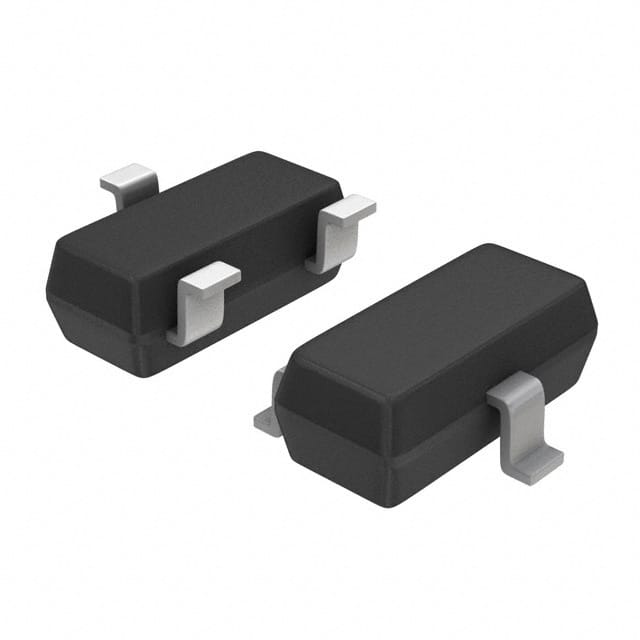Consulte las especificaciones para obtener detalles del producto.

MMBF4416LT1G
Introduction
The MMBF4416LT1G is a field-effect transistor (FET) belonging to the category of small signal transistors. This device is commonly used in various electronic applications due to its unique characteristics and versatile nature. In this entry, we will provide an overview of the MMBF4416LT1G, including its basic information, specifications, pin configuration, functional features, advantages and disadvantages, working principles, application field plans, and alternative models.
Basic Information Overview
- Category: Small Signal Transistor
- Use: Amplification and Switching in Electronic Circuits
- Characteristics: Low Power Dissipation, High Input Impedance, Low Noise
- Package: SOT-23
- Essence: N-Channel FET
- Packaging/Quantity: Tape & Reel, 3000 units per reel
Specifications
- Drain-Source Voltage (VDS): 40V
- Gate-Source Voltage (VGS): ±20V
- Continuous Drain Current (ID): 200mA
- Total Power Dissipation (PD): 225mW
- Operating Temperature Range: -55°C to 150°C
Detailed Pin Configuration
The MMBF4416LT1G features a standard SOT-23 package with three pins: 1. Source (S) 2. Gate (G) 3. Drain (D)
Functional Features
- High Input Impedance: Allows for easy interfacing with other circuit components.
- Low Power Dissipation: Suitable for low-power applications and helps in reducing heat generation.
- Low Noise: Provides clean and accurate signal amplification.
Advantages and Disadvantages
Advantages
- Versatile Application: Can be used in various electronic circuits for amplification and switching purposes.
- Small Package Size: SOT-23 package enables compact designs in space-constrained applications.
- Low Power Consumption: Ideal for battery-operated devices and low-power electronics.
Disadvantages
- Limited Current Handling: Not suitable for high-current applications.
- Voltage Limitations: The maximum drain-source voltage is 40V, restricting its use in high-voltage circuits.
Working Principles
The MMBF4416LT1G operates based on the principle of field-effect transistors, where the flow of current between the source and drain terminals is controlled by the voltage applied to the gate terminal. By modulating the gate-source voltage, the transistor can amplify or switch electronic signals effectively.
Detailed Application Field Plans
The MMBF4416LT1G finds extensive use in the following application fields: - Audio Amplifiers: Due to its low noise characteristics, it is suitable for audio signal amplification. - Sensor Interfaces: Its high input impedance makes it ideal for interfacing with various sensors. - Battery-Operated Devices: The low power dissipation makes it suitable for portable and battery-powered electronics.
Detailed and Complete Alternative Models
For users seeking alternative models to the MMBF4416LT1G, the following options are available: 1. MMBF5457LT1G: Similar N-channel FET with higher drain-source voltage capability. 2. MMBF170LT1G: Low threshold voltage FET suitable for specific low-voltage applications. 3. MMBFJ310LT1G: JFET alternative with similar characteristics for specific circuit requirements.
In conclusion, the MMBF4416LT1G offers a balance of performance and versatility, making it a popular choice for various electronic applications. Its compact size, low power consumption, and high input impedance make it well-suited for modern electronic designs.
Word Count: 498
Enumere 10 preguntas y respuestas comunes relacionadas con la aplicación de MMBF4416LT1G en soluciones técnicas
What is MMBF4416LT1G?
- MMBF4416LT1G is a N-channel JFET (junction field-effect transistor) designed for use in low-power applications.
What are the typical applications of MMBF4416LT1G?
- MMBF4416LT1G is commonly used in amplifier circuits, switch circuits, and voltage-controlled resistors.
What is the maximum drain-source voltage for MMBF4416LT1G?
- The maximum drain-source voltage for MMBF4416LT1G is 40V.
What is the maximum continuous drain current for MMBF4416LT1G?
- The maximum continuous drain current for MMBF4416LT1G is 50mA.
What is the gate-source cutoff voltage for MMBF4416LT1G?
- The gate-source cutoff voltage for MMBF4416LT1G typically ranges from -0.8V to -3V.
Can MMBF4416LT1G be used in high-frequency applications?
- MMBF4416LT1G is not recommended for high-frequency applications due to its relatively high input capacitance.
What are the key features of MMBF4416LT1G?
- Some key features of MMBF4416LT1G include low on-state resistance, low leakage current, and high forward transfer admittance.
Is MMBF4416LT1G suitable for battery-powered applications?
- Yes, MMBF4416LT1G is suitable for battery-powered applications due to its low power consumption and low voltage operation.
What are the thermal characteristics of MMBF4416LT1G?
- MMBF4416LT1G has a junction-to-ambient thermal resistance of 357°C/W, making it suitable for moderate power dissipation applications.
Are there any recommended alternative components to MMBF4416LT1G?
- Alternative components to MMBF4416LT1G include JFETs such as J175, J176, and J177, which have similar characteristics and can be used as substitutes in certain applications.

